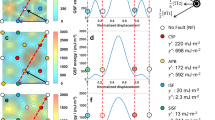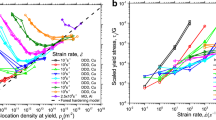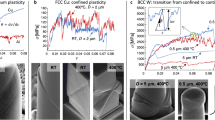Abstract
In simple crystalline materials, plastic deformation mostly takes place by the movement of dislocations. Although the underlying mechanisms in these materials are well explored, in complex metallic alloys—crystalline solids containing up to thousands of atoms per unit cell—the defects and deformation mechanisms remain essentially unknown. Owing to the large lattice parameters of these materials, extended dislocation concepts are required. We investigated a typical complex metallic alloy with 156 atoms per unit cell using atomic-resolution aberration-corrected transmission electron microscopy. We found a highly complex deformation mechanism, based on the movement of a dislocation core mediating strain and separate escort defects. On deformation, the escort defects move along with the dislocation core and locally transform the material structure for the latter. This mechanism implies the coordinated movement of hundreds of atoms per elementary glide step, and nevertheless can be described by simple rearrangement of basic structural subunits.
This is a preview of subscription content, access via your institution
Access options
Subscribe to this journal
Receive 12 print issues and online access
$259.00 per year
only $21.58 per issue
Buy this article
- Purchase on Springer Link
- Instant access to full article PDF
Prices may be subject to local taxes which are calculated during checkout




Similar content being viewed by others
References
Hirth, J. P. & Lothe, J. Theory of dislocations. (McGraw-Hill Series in Materials Science and Engineering, McGraw-Hill, 1968).
Kronberg, M. L. Plastic deformation of single crystals of sapphire—basal slip and twinning. Acta Metall. 5, 507–524 (1957).
Allen, C. W. & Liao, K. C. Dislocation models for shear transformation. Phys. Status Solidi A 74, 673–681 (1982).
Hazzledine, P. M. & Pirouz, P. Synchroshear transformations in Laves phases. Scripta. Met. 28, 1277–1282 (1993).
Chisholm, M. F., Kumar, S. & Hazzledine, P. Dislocations in complex materials. Science 307, 701–703 (2005).
Urban, K. & Feuerbacher, M. Structurally complex alloy phases. J. Non-Cryst. Sol. 334, 143–150 (2004).
Andersson, M., Feuerbacher, M. & Rapp, Ö. Magnetoresistance and Hall effect of the complex metal alloy Mg2Al3 . Phys. Rev. B 78, 024201 (2008).
Bauer, E. et al. Superconductivity in the complex metallic alloy beta-Al3Mg2 . Phys. Rev. B 76, 014528 (2007).
Jeglic, P. et al. NMR evidence for Co–Al–Co molecular groups trapped in cages of Co4Al13 . J. Alloys Compd. 480, 141–143 (2009).
Dolinsek, J. et al. Broken ergodicity, memory effect and rejuvenation in Taylor-phase and decagonal Al3(Mn,Pd,Fe) complex intermetallics. Phys. Rev. B 77, 064430 (2008).
Roitsch, S., Heggen, M., Lipinska-Chwalek, M. & Feuerbacher, M. Single-crystal plasticity of the complex metallic alloy phase beta-Al–Mg. Intermetallics 15, 833–837 (2007).
Klein, H., Feuerbacher, M., Schall, P. & Urban, K. Novel type of dislocation in an Al–Pd–Mn quasicrystal approximant. Phys. Rev. Lett. 82, 3468–3471 (1999).
Feuerbacher, M. & Heggen, M. On the concept of metadislocations in complex metallic alloys. Phil. Mag. 86, 935–944 (2006).
Taylor, M. A. Space group of MnAl3 . Acta Crystallogr. 14, 84 (1961).
Hiraga, K., Kaneko, M., Matsuo, Y. & Hashimoto, S. The structure of Al3Mn—close relationship to decagonal quasi-crystals. Phil. Mag. B 67, 193–205 (1993).
Klein, H. et al. The T–Al3(Mn,Pd) quasicrystalline approximant: Chemical order and phason defects. Phil. Mag. Lett. 75, 197–208 (1997).
Nellist, P. D. & Pennycook, S. J. The principles and interpretation of annular dark-field atomic Z-contrast imaging. Adv. Imaging Electron Phys. 113, 147–203 (2000).
Robinson, K. The determination of the crystal structure of Ni4Mn11Al60 . Acta Crystallogr. 7, 494–497 (1954).
Shi, N. C., Li, X. Z., Ma, Z. S. & Kuo, K. H. Crystalline phases related to a decagonal quasi-crystal. Acta Crystallogr. B 50, 22–30 (1994).
Balanetskyy, S., Meisterernst, G., Heggen, M. & Feuerbacher, M. Reinvestigation of the Al–Mn–Pd alloy system in the vicinity of the T- and R-phases. Intermetallics 16, 71–87 (2008).
Cottrell, H. Dislocations and Plastic Flow in Crystals (Clarendon Press, 1953).
Hemker, K. J., Mills, M. J. & Nix, W. D. An investigation of the mechanisms that control intermediate temperature creep of Ni3Al. Acta Metall. Mater. 39, 1901–1913 (1991).
Beraha, L., Duneau, M., Klein, H. & Audier, M. Phason defects in Al–Pd–Mn approximant phases: Another example. Phil. Mag. A 78, 345–372 (1998).
Heggen, M. & Feuerbacher, M. Metadislocation arrangements in the complex metallic alloy ξ′-Al–Pd–Mn. Phil. Mag. 86, 985–990 (2006).
Porter, D. A. & Easterling, K. E. Phase Transformations in Metals and Alloys (Chapman & Hall, 1992).
Feuerbacher, M., Balanetskyy, S. & Heggen, M. Novel metadislocation variants in orthorhombic Al–Pd–Fe. Acta Mater. 56, 1852–1859 (2008).
Klein, H. & Feuerbacher, M. Structure of dislocations and stacking faults in the complex intermetallic ξ′-Al–Pd–Mn. Phil. Mag. 83, 4103–4122 (2003).
Roitsch, S., Heggen, M. & Feuerbacher, M. Plastic deformation properties of the complex metallic alloy phase μ-Al–Mn. Intermetallics (in the press).
Roitsch, S. Microstructural and macroscopic aspects of the plasticity of complex metallic alloys. Thesis, RWTH-Aachen, full text at <http://hdl.handle.net/2128/3229> (2008).
Heggen, M., Houben, L. & Feuerbacher, M. Metadislocations in the orthorhombic structurally complex alloy Al13Co4 . Phil. Mag. 88, 2333–2338 (2008).
Heggen, M., Deng, D. & Feuerbacher, M. Plastic deformation properties of the orthorhombic complex metallic alloy phase Al13Co4 . Intermetallics 15, 1425–1431 (2007).
Acknowledgements
We thank C. Thomas and M. Schmidt for producing the materials and J. Barthel for carrying out the HAADF-STEM image simulation. This work was supported by the 6th Framework EU Network of Excellence ‘Complex Metallic Alloys’ (Contract No. NMP3-CT-2005-500140) and the Deutsche Forschungsgemeinschaft, (PAK 36).
Author information
Authors and Affiliations
Contributions
M.H. and M.F. contributed equally to the design of the experiment, the conduction of the deformation tests and the preparation of the manuscript. The microstructural investigations were carried out by L.H. and M.H. and the micrographs were analysed by M.H. M.F. developed the sample material and supervised the work.
Corresponding author
Ethics declarations
Competing interests
The authors declare no competing financial interests.
Supplementary information
Supplementary Information
Supplementary Information (PDF 891 kb)
Rights and permissions
About this article
Cite this article
Heggen, M., Houben, L. & Feuerbacher, M. Plastic-deformation mechanism in complex solids. Nature Mater 9, 332–336 (2010). https://doi.org/10.1038/nmat2713
Received:
Accepted:
Published:
Issue Date:
DOI: https://doi.org/10.1038/nmat2713
This article is cited by
-
Precipitation Behavior and Mechanical Properties of a Ni-Based Alloy with Different Silicon Contents
Journal of Materials Engineering and Performance (2023)
-
Plasticity without dislocations in a polycrystalline intermetallic
Nature Communications (2019)
-
A universal state and its relaxation mechanisms of long-range interacting polygons
Nature Communications (2019)
-
Discharge and densification in the spark plasma sintering of quasicrystal particles
Journal of Materials Science (2019)
-
Multiple quasicrystal approximants with the same lattice parameters in Al-Cr-Fe-Si alloys
Scientific Reports (2017)



